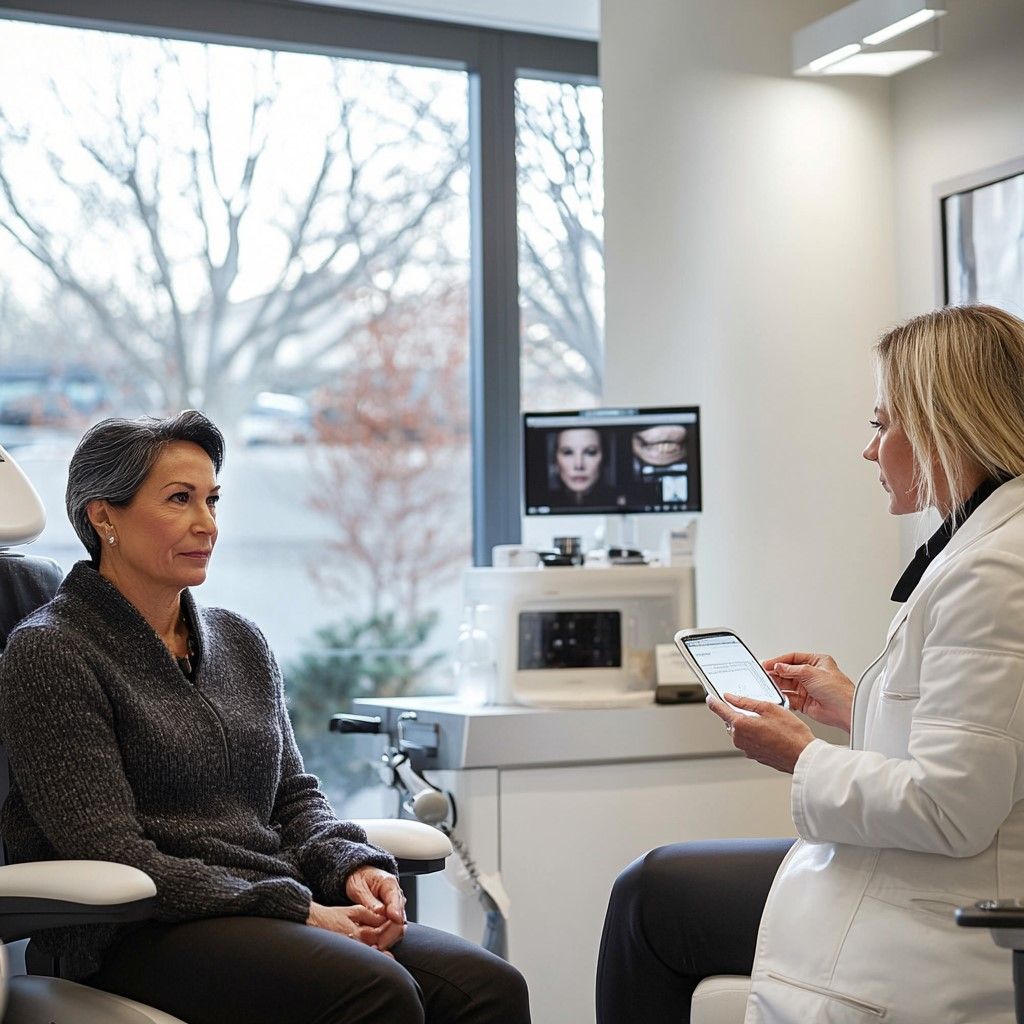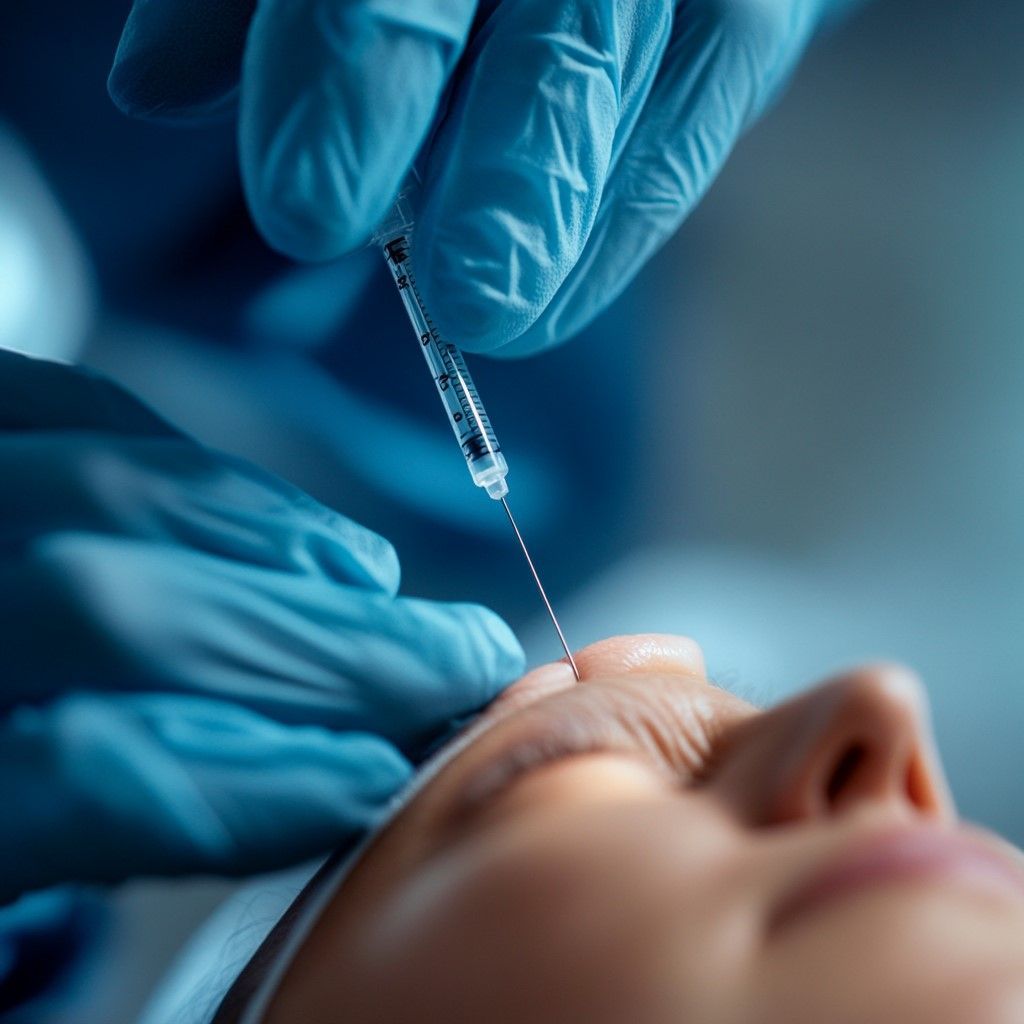PDO Threads Lifting in Louisville – Benefits & Results
As we get older, it’s natural for our skin to lose its firmness, leading to sagging in areas like the cheeks and jawline. If you’ve ever looked in the mirror and wished for a little lift without going under the knife, you’re not alone.
That’s where the PDO thread lift comes in—a minimally invasive treatment that helps tighten and refresh your appearance without the downtime of major surgery.
Understanding PDO Thread Lifts
PDO thread lifts offer a non-surgical way to lift and tighten skin. But what makes PDO threads effective?
What Are PDO Threads?
Polydioxanone (PDO) threads are biodegradable sutures traditionally used in medical settings for procedures like suturing incisions. In aesthetic medicine, these threads have found a new purpose: lifting and tightening sagging skin. Their biocompatible nature ensures they are safely absorbed by the body over time, making them ideal for cosmetic enhancements.
How Do PDO Thread Lifts Work?
The PDO thread lift procedure involves inserting these threads beneath the skin using fine needles. Once in place, the threads provide an immediate lifting effect by physically supporting the skin.
Beyond this initial lift, PDO threads stimulate the body's natural collagen production, enhancing skin elasticity and firmness over time. Unlike traditional facelifts that require significant surgical intervention, PDO thread lifts offer a subtler, yet effective, alternative with reduced recovery times.
Types of PDO Threads
There are many types of PDO threads, each designed for specific aesthetic goals.
Mono Threads
Mono threads are smooth, singular threads inserted into the skin to promote collagen production. They are primarily used to rejuvenate and tighten the skin rather than lift it. Commonly applied to areas like the neck and forehead, mono threads improve skin texture and reduce fine lines. However, they may not provide the lifting effect desired for more pronounced sagging.
Cog Threads
Cog threads are equipped with barbs that latch onto the skin's underlying tissues, providing both support and lift. These threads are effective for redefining the jawline and lifting sagging cheeks. The barbs stimulate collagen production, enhancing the skin's structure and firmness. Cog threads offer a more pronounced lifting effect compared to mono threads, making them suitable for areas requiring more significant elevation.
Screw Threads
Screw threads have at least one or two intertwined threads designed to restore volume to sunken areas of the skin. They are particularly effective in areas like the nasolabial folds and cheeks, where added fullness is desired. By stimulating collagen production and providing a subtle lift, screw threads enhance facial contours and rejuvenate the skin's appearance.
Target Areas for PDO Thread Lifts
A thread lift is commonly used to target areas of the face that lose firmness over time, such as:
- Jowls and jawline
- Under-eye area
- Forehead
- Cheeks
- Browline
Additionally, thread lifts can help lift and tighten the breasts, particularly after pregnancy or weight loss.
PDO Thread Lifts Procedure Overview

The PDO thread lift procedure is straightforward and minimally invasive, making it a popular choice for skin rejuvenation. Here’s what to expect.
Consultation Process
A thorough consultation is essential before undergoing a PDO thread lift. During this session, the practitioner assesses your facial structure, skin condition, and discusses your aesthetic goals. This assessment helps match your treatment plan to your goals and finds the best thread type and placement. Setting realistic expectations is important for achieving the results you want.
The Treatment Day
On procedure day, the area is cleaned, and a local anesthetic is applied to keep you comfortable. Using fine needles, the practitioner inserts the PDO threads into predetermined areas beneath the skin. The PDO thread lifting procedure usually takes around 45 minutes to an hour, depending on the extent of treatment. Patients may experience mild pressure or tugging sensations but should not feel significant pain.
Post-Procedure Care
After the procedure, it's common to experience mild swelling, soreness, or bruising in the treated areas. To promote optimal recovery time, avoid strenuous activities, facial massages, and excessive facial movements for at least a week. Sleeping on your back with your head elevated can help reduce swelling. Adhering to the practitioner's aftercare instructions is vital to ensure the best possible results and minimize potential complications.
Benefits of PDO Thread Lifts
PDO thread lifts offer many benefits, making them a popular choice for non-surgical facial rejuvenation. Here’s what makes this treatment stand out;
Immediate Results
One of the best features of PDO thread lifts is the instant improvement in skin tightness and lift. Patients often notice a visible enhancement right after the procedure, providing instant gratification.
Long-Term Improvements
Beyond the initial lift, PDO threads stimulate the production of collagen, leading to continued improvements in skin texture, elasticity, and firmness over several months. This ongoing rejuvenation process results in a more youthful and refreshed appearance that typically lasts up to 18 months, depending on individual factors.
Minimal Downtime
Compared to traditional surgical facelifts, PDO thread lifts require significantly less recovery time. Most patients can return to their daily activities within a few days, making it a great option for those with busy lifestyles seeking effective yet convenient cosmetic enhancements.
Safety Profile
PDO thread lifts are considered low-risk procedures when performed by qualified practitioners. The threads are biodegradable and safely absorbed by the body over time, reducing the risk of adverse reactions. Also, the minimally invasive nature of the procedure minimizes the likelihood of scarring and other complications associated with more invasive surgeries.
PDO Thread Lifts Potential Risks & Considerations

Like any cosmetic procedure, PDO thread lifts come with potential risks and side effects. Understanding these risks can help you make an informed decision.
Common Side Effects
While PDO thread lifts are generally safe, some common side effects may occur, such as swelling, bruising, and mild discomfort at the insertion sites. These effects are temporary and subside within a few days to a week. Following post-procedure care instructions can help mitigate these symptoms.
Rare Complications
Although uncommon, certain complications can arise, such as infection, thread migration, or visibility of the threads beneath the skin. Choosing an experienced practitioner and adhering to aftercare guidelines significantly reduce the risk of these issues. If any unusual symptoms occur, it's important to contact your healthcare provider promptly.
Who Should Avoid a PDO Thread Lift?
While PDO thread lifts are generally safe, they aren’t suitable for everyone.
Here’s who should avoid the procedure:
Absolute Contraindications (Not Safe for These Conditions)
- Active infections in the treatment area
- Uncontrolled diabetes
- Blood clotting disorders (e.g., hemophilia)
- Autoimmune diseases (e.g., scleroderma, sarcoidosis)
- Pregnant or breastfeeding individuals
Relative Contraindications (Use Caution or Consult a Doctor)
- History of keloid scarring (may increase risk of scarring)
- Use of anticoagulant medications (can cause excessive bleeding)
- Psychological concerns or unrealistic expectations (may not be satisfied with results)
Consultation is Key
To ensure a PDO thread lift is right for you, be honest about your medical history during your consultation. A qualified practitioner can assess your suitability and help you make an informed decision.
Comparing PDO Thread Lifts to Other Aesthetic Procedures
When exploring facial rejuvenation, it’s helpful to compare PDO thread lifts with other procedures. Here’s how they stack up against traditional facelifts.
PDO Thread Lifts vs. Traditional Facelifts
When considering facial rejuvenation, it's important to weigh the options between PDO thread lifts and traditional surgical facelifts. Traditional facelifts involve invasive surgery, general anesthesia, and significant recovery time. They provide comprehensive results, particularly for individuals with advanced skin laxity. However, the invasiveness and potential for complications may deter some patients.
In contrast, PDO thread lifts offer a minimally invasive alternative. The procedure involves local anesthesia, minimal downtime, and a lower risk profile. While the results are more subtle and may not last as long as a surgical facelift, PDO thread lifts are ideal for individuals with mild to moderate skin sagging seeking a less invasive option.
PDO Thread Lifts vs. Dermal Fillers
Dermal fillers and PDO thread lifts both aim to rejuvenate the face but achieve this through different mechanisms. Dermal fillers involve injecting substances like hyaluronic acid to add volume, smooth wrinkles, and enhance facial contours. They are particularly effective for addressing volume loss and fine lines.
PDO thread lifts, on the other hand, focus on lifting and tightening the skin by inserting threads that stimulate collagen production. This approach is beneficial for individuals experiencing skin laxity and sagging. In some cases, combining both treatments can provide synergistic effects, offering both lift and volume restoration for a more comprehensive rejuvenation.
Combining Treatments
For optimal facial rejuvenation, combining PDO thread lifts with other aesthetic procedures can enhance results. For instance, combining thread lifts with dermal fillers can tighten skin and restore volume for a more youthful look.
Additionally, treatments like Botox can complement PDO thread lifts by relaxing dynamic wrinkles, while skin resurfacing procedures can improve skin texture and tone. A personalized treatment plan developed in consultation with a qualified practitioner can determine the best combination of procedures to meet your aesthetic goals.
Where to Get a PDO Thread Lift in Louisville

Selecting an experienced practitioner is vital to achieving safe and satisfactory results with PDO thread lifts. An expert will have a complete understanding of facial anatomy, proper thread placement techniques, and the ability to manage potential complications. This ensures that the procedure is performed effectively and safely, minimizing risks and enhancing outcomes.
Why Choose Facial Aesthetics by Design
At Facial Aesthetics by Design, we’re all about helping you look and feel your best. Lead by Dr. Melanie Peterson, we focus on personalized care, ensuring your treatments align with your goals. Located in East Louisville, KY, our clinic is a friendly and professional space where you can relax and feel confident in your results.
About Dr. Melanie Peterson
Dr. Melanie Peterson is a graduate of University of Louisville School of Dentistry, Dr. Peterson has extensive expertise in public health dentistry, dental education, and aesthetic treatments, including BOTOX®, fillers, and PDO threads. Her in-depth knowledge of facial anatomy allows her to provide integrated services that enhance client experiences and deliver exceptional results.
Frequently Asked Questions (FAQs)
1. What is the typical cost of a PDO thread lift?
The cost of a PDO thread lift varies based on factors such as the number of threads used, the areas treated, and the practitioner's expertise. On average, the price of the procedure can range from $1,500 to $4,500. It's best to consult with your provider for a personalized quote.
2. How long do the results last?
Results from a PDO thread lift typically last between 12 to 18 months. Factors such as age, skin condition, and lifestyle can influence the longevity of the results.
3. Is the PDO thread lift procedure painful?
Most patients experience slight discomfort during the procedure, as local anesthesia is used to numb the treatment area. Some soreness or tenderness may occur post-procedure but usually subsides within a few days.
4. How soon can I return to work after the procedure?
One of the advantages of a PDO thread lift is the minimal downtime. Most patients can return to work within a few days post-procedure. However, it's recommended to avoid strenuous activities and follow post-procedure care measurements to ensure optimal healing.
5. Are there any long-term side effects?
PDO thread lifts are generally safe, but rare long-term side effects like skin dimpling, thread extrusion, or prolonged discomfort can occur. Choosing a skilled practitioner and following care instructions can help minimize risks.
Conclusion
PDO thread lifts offer a minimally invasive solution for people seeking to address signs of aging, such as skin laxity and sagging. With immediate results, ongoing collagen stimulation, and minimal downtime, this procedure has become an attractive option for many. However, it's important to consider potential risks and consult with a qualified professional to determine if it's the right choice for you.
Trust our medical aestheticians to guide you throughout the process - schedule your consultation with Facial Aesthetics by Design. Start your journey to a more youthful you today.

Dr. Melanie Peterson
Learn about Dr. Melanie Peterson, whose diverse expertise in dentistry and facial aesthetics brings a comprehensive approach to enhancing client experiences.


